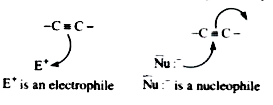1) The unit of an alkyne is more acidic than a C – H unit of an alkene or alkane, allowing acetylene and terminal alkynes to be converted to their conjugate bases .
2) Unlike alkenes, alkynes are reduced by metals, especially Li, Na and K.
3) Unlike alkenes, alkynes can undergo nucleophilic as well as electrophilic addition.

Which of the following best describes what happens in the first step in the mechanism of the hydrogen - deuterium exchange reaction shown?
Solution in Telugu




The correct Answer is:A
Conceptual
Similar Questions
A : Alkynes is more reactive than alkene towards electrophilic addition reaction. R : Alkynes form stable carbocation than alkene.
02:13View SolutionAlkenes or alkynes are more reactive than their corresponding alkane.
View Solution1) The ≡C−H unit of an alkyne is more acidic than a C – H unit of an alkene or alkane, allowing acetylene and terminal alkynes to be converted to their conjugate bases ≡C.
2) Unlike alkenes, alkynes are reduced by metals, especially Li, Na and K.
3) Unlike alkenes, alkynes can undergo nucleophilic as well as electrophilic addition.

Which of the following best describes what happens in the first step in the mechanism of the hydrogen - deuterium exchange reaction shown?
CH3−C≡CDNaNH2−−−−→NH3CH3C≡CH02:28View Solution1) The -=C-H unit of an alkyne is more acidic than a C – H unit of an alkene or alkane, allowing acetylene and terminal alkynes to be converted to their conjugate bases -= C . 2) Unlike alkenes, alkynes are reduced by metals, especially Li, Na and K. 3) Unlike alkenes, alkynes can undergo nucleophilic as well as electrophilic addition. Which of the following best describes what happens in the first step in the mechanism of the reaction shown? CH_3 CH_2CH_2CHBr_2 + 3NaNH_2 overset(NH_3)to CH_3CH_2C -=CNa +2NaBr +3NH_3
01:54View Solution1) The -=C-H unit of an alkyne is more acidic than a C – H unit of an alkene or alkane, allowing acetylene and terminal alkynes to be converted to their conjugate bases -= C . 2) Unlike alkenes, alkynes are reduced by metals, especially Li, Na and K. 3) Unlike alkenes, alkynes can undergo nucleophilic as well as electrophilic addition. Which of the following best describes what happens in the first step in the mechanism of the reaction shown? CH_3 CH_2CH_2CHBr_2 + 3NaNH_2 overset(NH_3)to CH_3CH_2C -=CNa +2NaBr +3NH_3
03:49View SolutionHow is alkyne converted into alkene?
03:18View SolutionHalogenation OF Alkenes and Alkynes, Addition OF X2 with Alkenes and Alkynes
01:14:42View Solution

